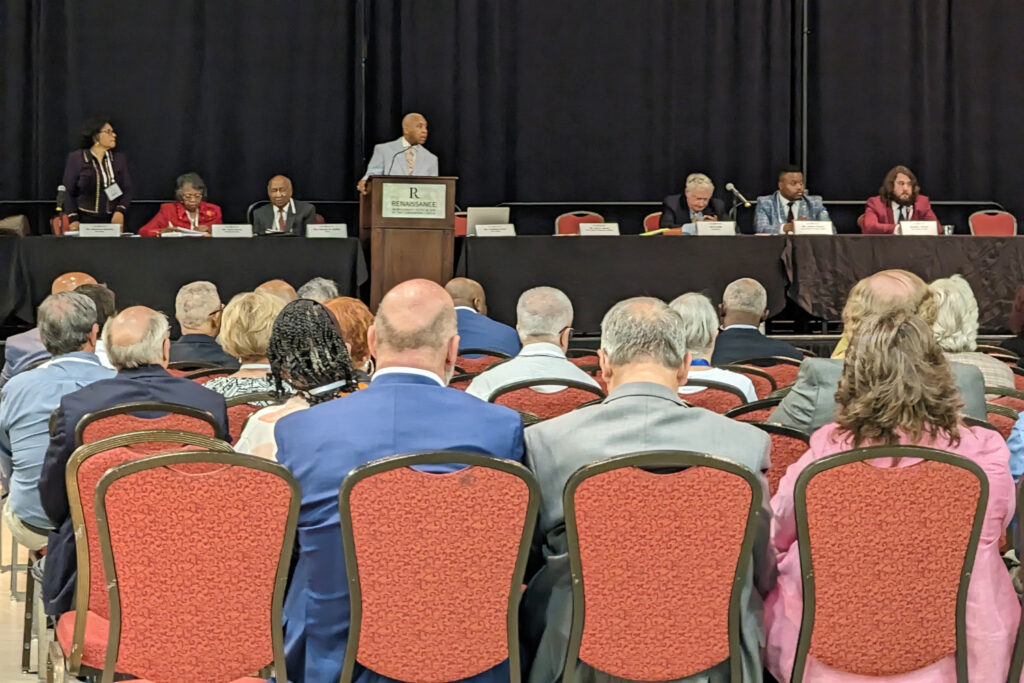
Randy Kelley, chairman of the Alabama Democratic Party, presides over the State Democratic Executive Committee in May 2023. Democratic turnout in Alabama has been falling in recent years; Kamala Harris got 10% fewer votes this month than Joe Biden got in 2020. (Alander Rocha/Alabama Reflector)
This is the existential problem for the Alabama Democratic Party: their voters aren’t showing up.
And it’s not an issue because we’re on the brink of some political revolution in the state. Alabama is not about to tip blue. The Republican supermajority in the Legislature is not on the brink of collapse.
No, we’re talking about threats to the few sandbars of power Democrats still occupy.
Turn the clock back two years. Several Democrats in majority-Black legislative districts — which should be easy wins — had less-than-overwhelming victories.
Robert L. Stewart, running for state Senate in a district centered around Selma, got just 53% of the vote. Rep. Thomas Jackson, D-Thomasville, eked out a 556-vote victory in his district.
There was a lot going on here. The Black Belt, a Democratic bastion, continues to shrink. Voting in 2022 was a lot harder than voting in 2020, when Republican state officials took a brave step into 2006 and briefly gave us what amounted to early voting. (After the election, they dialed the state’s election apparatus back to 1958.)
Those factors are out of the party’s control. But finding candidates isn’t. And in 2022, the Democrats’ candidate recruitment was as ineffective as Auburn’s quest for offensive linemen.
The party left most state and legislative races uncontested. Many Democrats who appeared on the ballot tripped their way in. Yolanda Flowers, the party’s 2022 gubernatorial nominee, had never previously run for office; had an abortion stance that can be charitably described as muddled and managed to be massively outspent by Libertarian Party nominee James Blake, who spent just $44,000 on his campaign.
I doubt any Democratic candidate could have beaten Republican Gov. Kay Ivey that year. (For that matter, neither could the Republicans who challenged her in the primary.) But if you don’t have someone running a statewide campaign reaching your party’s supporters, you’re going to have a lot of people staying home.
Fewer than 38% of Alabama’s registered voters cast ballots that year. And a lot of the people who didn’t were Democrats. That created a lot of problems for Democratic legislators.
The results this month don’t look any better.
A little over 58.5% of Alabama’s registered voters cast ballots on Nov. 5, the lowest turnout for a presidential election in the state since 1988.
Republican turnout was flat. Pike County, which Trump won, recorded only 89% of the vote it had four years ago. In deep-red Dale County, only 51% of voters turned out.
But the story here is Democratic votes disappearing. And not only in areas where Jesus couldn’t win as a Democrat.
In Jefferson County, there were 20,000 fewer votes for Kamala Harris than for Joe Biden in 2020.
In Mobile, Democratic votes fell by over 8,000. In Montgomery, the blue vote total fell by 6,800.
In Tuscaloosa and Lee, two growing university counties, there were 4,000 fewer votes each.
In all, the Democrats got nearly 10% fewer votes in 2024 than they did in 2020. Shomari Figures’ victory in the 2nd Congressional District didn’t help, either. Mobile and Montgomery, the largest cities in the district, recorded below-average turnout, as did Macon County, a Democratic stronghold where less than half of the voters cast a ballot.
If the party is going to maintain its viability in Alabama, the cities and the Black Belt should be a base to support growth elsewhere. If Democrats have to focus their efforts on shoring up the foundation, they’re not going anywhere.
And this is in a presidential election year, where most everyone knows they have to vote. What happens in 2026, when turnout is almost certain to fall further? And if the Democratic primary becomes another open mic night with no one in the audience?
I can tell you: Black Belt legislators are going to have to fight for seats that shouldn’t be in play. And the party’s path back to relevance in the Legislature gets even longer.
Democrats have to find strong candidates up and down the ballot, but especially at the top. And that’s a challenge. You need people with name recognition willing to run long, difficult statewide campaigns where they’ll be lucky to finish with 40% of the vote.
But they don’t have a choice. Leave those top slots vacant or let someone stumble onto the ballot, and they’re going to lose a lot of races they ought to win. In the Legislature and outside it. Maybe even in the newly drawn 2nd Congressional District.
A mayor seems the most obvious choice. Tuscaloosa’s Walt Maddox didn’t come close to getting into the governor’s mansion in 2018. But he raised money, bought ads and reminded Democrats that there was an election. There were Democrats running for most offices. If nothing else, they held the line.
If it’s not a mayor, find a former federal official; the party did well in 2017 with a former U.S. attorney. Or find a retired statewide official. Run former Gov. Don Siegelman if you like. Alabamians no longer care about candidates with felony convictions. Siegelman has far fewer of them than the President-elect.
But whoever it is, start recruiting those candidates now. Because if Democrats can’t find candidates Democratic voters care about, they’re going to lose a lot more than the governor’s race.
YOU MAKE OUR WORK POSSIBLE.

